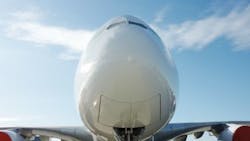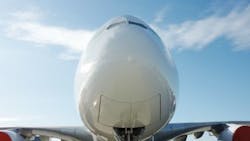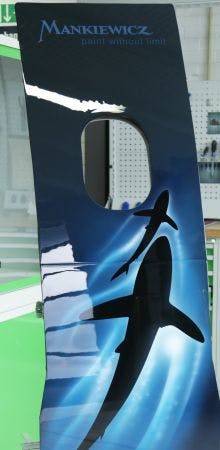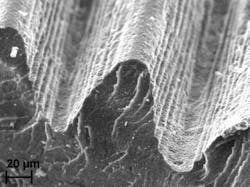Laser specialist 4JET (Alsdorf, Germany) and aircraft paint supplier Mankiewicz (Hamburg, Germany) are developing a laser surface treatmentprocess that automatically creates fuel-saving riblets onto painted aircraft surfaces. The Laser Enhanced Air Flow (LEAF) technology uses the principle of laser interference patterning to quickly create fine lateral grooves in the uppermost layer of aircraft paint.
Such riblets reduce drag up to 10%, which results in fuel savings for commercial long-haul airlines by more than 1%—equaling potential savings on total global kerosene spending of $150 billion annually.
Aircraft exterior coatings could benefit from fine lateral grooves (riblets) that could, for instance, contribute to fuel savings.
Usingpaint removal lasers, a well-known technology, proved to be too slow to create the high density of riblets required to achieve "shark skin" effects. Instead of creating the riblet grooves with one focused laser spot "line by line," 4JET has found a way to speed up the process by a factor of about 500 using the principle of laser interference patterning. The laser beam is split up and recombined on the surface in such a way that the electric field oscillations of the light waves superpose in a controlled manner. This superposition creates a distinct pattern of dozens of alternating equidistant lines within one single laser spot. This enables the creation of 15 kilometers of riblets—equal to about 1 m2 of riblet surface—within less than one minute.
The LEAF laser surface treatment method for aircraft exterior paint is inspired by shark skin.
LEAF works dry without any consumables and allows adjustment of riblet geometries, depending on their location on the aircraft. The paint dust and vapor created during the process is evacuated and the process does not require post-processing. The technology enables processing of curved or riveted surfaces, and can be integrated with existing robotics used for paint removal or printing operations in aircraft maintenance.
Laser-powered drag reduction creates hundreds of riblets within a second.
The companies are jointly developing the LEAF technology for use on aircraft and are preparing for its commercialization within the coming years. Mankiewicz will support the development with its deep understanding of paint chemistry and the requirements of the aviation, while 4JET will focus on the development of the laser process and the riblet forming system.
For more information, please visit 4jet.de and mankiewicz.com.



